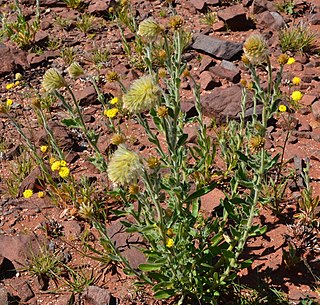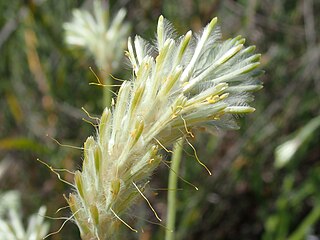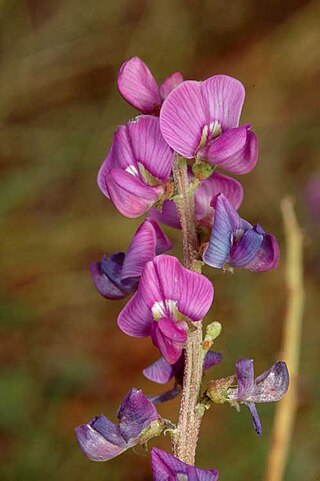
Ptilotus is a genus of approximately 125 species of flowering plants in the family Amaranthaceae, and is endemic to Australia, apart from Ptilotus conicus that also occurs in Malesia. Plants in the genus Ptilotus are annual or perennial herbs or shrubs with usually hairy spikes of compact spherical, oval or cylindrical flowers.

Ptilotus exaltatus, more commonly known as pink mulla mulla, is an erect annual herb endemic to large parts of arid and semi-arid Australia. It grows throughout most areas of Australia except the Nullarbor Plain, occurring geographically above a line drawn from Perth to Esperance. The species was first observed and described in 1810, and comprehensively catalogued in 1971.

Ptilotus clementii, commonly known as tassel top, is a native Australian annual herb growing to between 0.3 and 1 metre high. Nodding, green flower spikes are produced between March and November in the species' native range.

Achyranthes aspera is a species of plant in the family Amaranthaceae. It is distributed throughout the tropical world. It can be found in many places growing as an introduced species and a common weed. It is an invasive species in some areas, including many Pacific Islands environments.

Petrophile helicophylla is a species of flowering plant in the family Proteaceae and is endemic to southwestern Western Australia. It is a prostrate, spreading shrub with twisted, needle-like leaves and heads of hairy white to creamy-white or pale pink flowers.

Ptilotus polystachyus is a perennial herb in the Amaranthaceae family.

Ptilotus schwartzii is a grass-like plant in the Amaranthaceae family.

Teucrium argutum, commonly known as native germander, is a species of flowering plant in the family Lamiaceae, and is endemic to eastern Australia. It is a perennial herb often suckering, with hairy, broadly egg-shaped leaves with toothed or wavy edges, and pink-purple flowers.
Patersonia rudis, commonly known as hairy flag, is a species of plant in the iris family Iridaceae and is endemic to the south-west of Western Australia. It is a tufted, rhizome-forming perennial herb with linear to sword-shaped leaves and violet tepals.

Ptilotus latifolius, the tangled mulla mulla, is a perennial herb that is native to Australia, which grows abundantly on sand dunes and stony plains. The key diagnostic features of this plant are its very stem bound, shrub like appearance with densely clustered white white flowers with pink tips when newly blossomed. Each stem is generally supported by one to two leaves and the stems have a fluffy textures as well as the flowers. The petiole is generally long in this species and spike bound.

Swainsona affinis, commonly known as common poison pea, is a species of flowering plant in the family Fabaceae and is endemic to arid areas of inland Australia. It is a prostrate perennial herb with imparipinnate leaves with 7 to 25 broadly elliptic leaflets, and racemes of purple, pink, yellow or white flowers.
Swainsona disjuncta is a species of flowering plant in the family Fabaceae and is endemic to widely separated areas of central Australia. It is a prostrate perennial herb with imparipinnate leaves with 3 to 9 egg-shaped leaflets, and racemes of purple, pink or red flowers in racemes of 3 to 15.

Swainsona flavicarinata is a species of flowering plant in the family Fabaceae and is endemic to inland areas of continental Australia. It is a prostrate to more or less erect perennial herb, with imparipinnate leaves with 5 to 9 egg-shaped leaflets with the narrower end towards the base, and racemes of 3 to 15 purple, red or pink flowers.
Ptilotus actinocladus is a species of flowering plant in the family Amaranthaceae and is endemic to inland Western Australia. It is a prostrate annual herb with a central stem and radiating lateral stems, linear to lance-shaped stem leaves, pink spherical or cylindrical spikes of flowers with long, silky hairs, and four fertile stamens.

Ptilotus aervoides, commonly known as mat mulla mulla, is a species of flowering plant in the family Amaranthaceae and is endemic to western Australia. It is a prostrate, mat-forming annual or short-lived perennial herb, its stems densely hairy at first, egg-shaped to spatula-shaped stem leaves, dense spikes of hairy creamy-green flowers with two or three fertile stamens.

Ptilotus albidus is a species of flowering plant in the family Amaranthaceae and is endemic to inland Western Australia. It is a compact perennial shrub with linear leaves, spherical spikes of white flowers and dull brown seeds.
Ptilotus alexandri is a species of flowering plant in the family Amaranthaceae and is endemic to the far west of Western Australia. It is an erect, annual herb with spatula-shaped leaves, spikes of pink flowers and glossy black seeds.
Ptilotus andersonii is a species of flowering plant in the family Amaranthaceae and is endemic to a restricted area of Western Australia. It is a prostrate, hairy, perennial herb with a spatula-shaped to lance-shaped leaves at the base of the plant, lance-shaped cauline leaves, and pink, oval spikes of flowers with two fertile stamens.
Ptilotus angustifolius, commonly known as regal fox tails, is a species of flowering plant in the family Amaranthaceae and is endemic to South Australia. It is a low, bushy herb with a several stems, narrowly egg-shaped leaves at the base of the plant, oval, intensely fragrant spikes of purple flowers and cylindrical heads of many long, hairy fruits.

Ptilotus aphyllus is a species of flowering plant in the family Amaranthaceae and is endemic to the a small area of inland Western Australia. It is a leafless perennial, except when young, and spikes of purple flowers fading to pink and pale orange.














